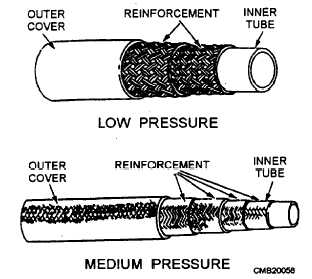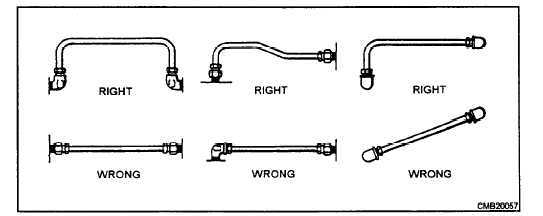Aluminum. - Aluminum is limited to low- pressure use, yet it has good flaring and bending characteristics.
Plastic. - Plastic tubing lines are made from a variety of materials; nylon is the most suitable for use in low-pressure hydraulic applications ONLY.
There are three important dimensions of any tubular product - outside diameter (OD), inside diameter (ID), and wall thickness. Sizes of pipe are listed by the nominal (or approximate) ID and wall thickness. Sizes of tubing are listed by the actual OD and the wall thickness.
The material, the inside diameter, and the wall thickness are the three primary considerations in the selection of lines for the circulatory system of a particular fluid power system.
The manufacturers of tubing and pipe usually supply charts, graphs, or tables which aid in the selection of proper lines for fluid power systems. These tables and charts use different methods for deriving the correct sizes of pipe and tubing.
Line should normally be kept as short and free of bends as possible. However, tubing should NOT be assembled in a straight line, because a bend tends to eliminate strain by absorbing vibration and compensates for thermal expansion and contraction. Bends are preferred to elbows, because bends cause less of a power loss. A few of the incorrect and correct methods of installing tubing are shown in figure 3-35.
FLEXIBLE HOSE. - Hose is used in fluid power systems where there is a need for flexibility, such as connection to units that move while in operation or to units attached to a hinged portion of the equipment. It is also used in locations that are subjected to severe vibration. Flexible hose is usually used to connect the pump to the system. The vibration that is set up by the operating pump would ultimately cause rigid tubing to fail.
Flexible hose is designated by a dash number, which is the ID of the hose expressed in 16ths of an inch and is stenciled on the side of the hose. For example, the inside of a -16 hose is 1 inch. For a few hose styles, this is approximate and is not a true ID.
Rubber hose is designed for specific fluid, temperature, and pressure ranges and is provided in various specifications. Flexible hydraulic hose is composed of three basic parts (fig. 3-36):
Inner Tube. - The inner tube is a synthetic rubber layer that is oil-resistant. It must be smooth, flexible, and able to resist heat and corrosion.
Reinforcement Layers. - The reinforcement layers vary with the type of hose. These layers (or plies) are constructed of natural or synthetic fibers, braided wire, or a combination of these. The strength of this layer depends upon the pressure requirement of the system.

Figure 3-36. - Flexible rubber hose construction.

Figure 3-35. - Correct and incorrect methods of installing tubing.
Continue Reading